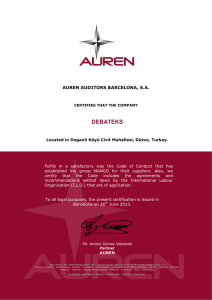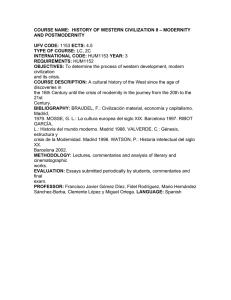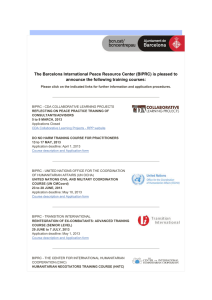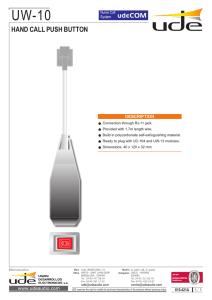1 RÉSUMÉ Dr. Jaume Llop-Raduà Date of Birth: December 13th
Anuncio
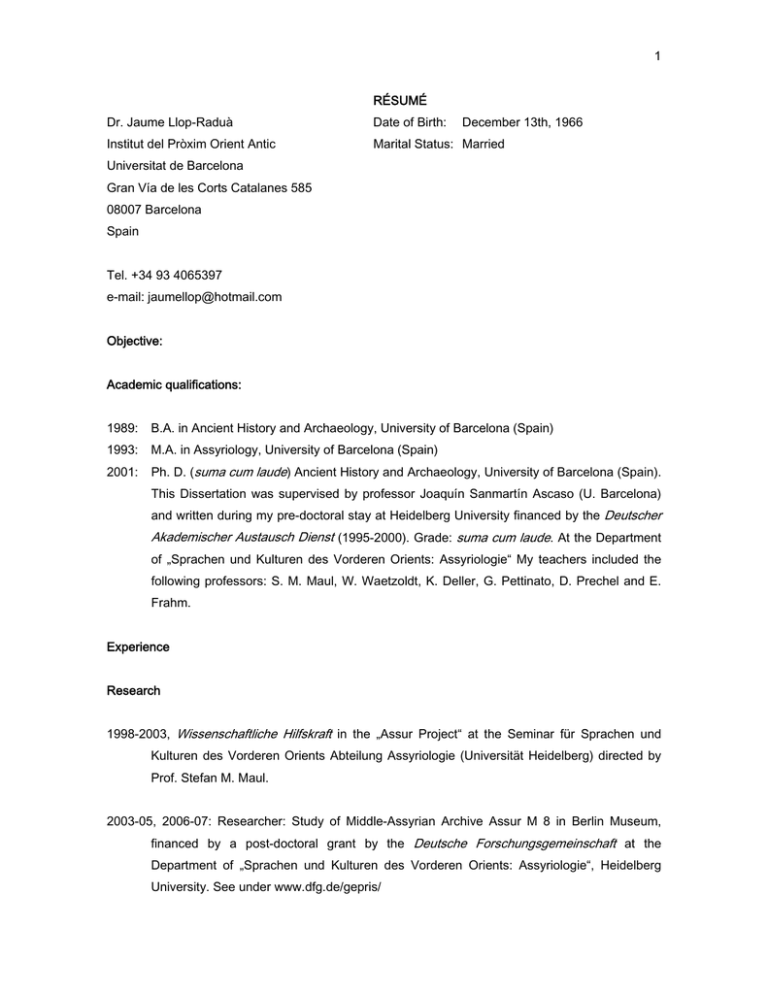
1 RÉSUMÉ Dr. Jaume Llop-Raduà Date of Birth: December 13th, 1966 Institut del Pròxim Orient Antic Marital Status: Married Universitat de Barcelona Gran Vía de les Corts Catalanes 585 08007 Barcelona Spain Tel. +34 93 4065397 e-mail: [email protected] Objective: Academic qualifications: 1989: B.A. in Ancient History and Archaeology, University of Barcelona (Spain) 1993: M.A. in Assyriology, University of Barcelona (Spain) 2001: Ph. D. (suma cum laude) Ancient History and Archaeology, University of Barcelona (Spain). This Dissertation was supervised by professor Joaquín Sanmartín Ascaso (U. Barcelona) and written during my pre-doctoral stay at Heidelberg University financed by the Deutscher Akademischer Austausch Dienst (1995-2000). Grade: suma cum laude. At the Department of „Sprachen und Kulturen des Vorderen Orients: Assyriologie“ My teachers included the following professors: S. M. Maul, W. Waetzoldt, K. Deller, G. Pettinato, D. Prechel and E. Frahm. Experience Research 1998-2003, Wissenschaftliche Hilfskraft in the „Assur Project“ at the Seminar für Sprachen und Kulturen des Vorderen Orients Abteilung Assyriologie (Universität Heidelberg) directed by Prof. Stefan M. Maul. 2003-05, 2006-07: Researcher: Study of Middle-Assyrian Archive Assur M 8 in Berlin Museum, financed by a post-doctoral grant by the Deutsche Forschungsgemeinschaft at the Department of „Sprachen und Kulturen des Vorderen Orients: Assyriologie“, Heidelberg University. See under www.dfg.de/gepris/ 2 2007-2012: Researcher, contracted by the Spanish Science and Technology Ministry (“Ramón y Cajal” Contract) at the IPOA (Institute for the Studies of the Ancient Near East) of the University of Barcelona. Teaching University of Barcelona (Spain) Thirty hours teaching undergraduate students at the Faculty of Geography and History of the University of Barcelona (1990-1993). University of Heidelberg (Germany) -From Oct. 1998- Feb. 1999 until Oct. 2006- Feb. 2007 (17 semesters, ca. 32 hours per semester = 576 hours): „Akkadisch“ (Akkadian-Tutorial). -Oct. 2003- Feb. 2004 (1 semester, ca. 32 hours): „Die mittelassyrischen Gesetze als Quelle der Gesellschaft“ (The Middle-Assyrian Laws as Source for the Study of Society). -April-July 2004 (1 semester, ca. 32 hours): „Der Harem im Assyrien“ (The Harem in Assyria). -Oct. 2004- Feb. 2005 (2 hours): „Einführung in die Geschichte des Alten Orients. Die frühneuassyrische Zeit von Aššur-dān II. bis Aššur-nārārī V. (934-745 v. Chr.)“ (Introduction to the History of the Ancient Near East: The Early Neo-Assyrian Empire, from Aššur-dān II. bis Aššur-nārārī V. [934-745 v. Chr.]). -April-July 2005 (2 hours): „Einführung in die Kulturgeschichte des Alten Orients: Rechtswesen“ (Introduction to the Ancient Near Eastern Civilization: the Law) -Oct. 2005- Feb. 2006 (1 semester, ca. 32 hours): „Die Geschenke des assyrischen Königs (mA und nA)” (The Presents of the Assyrian King (Middle- and Neo-Assyrian) -Oct. 2005- Feb. 2006 (2 hours): „Einführung in die Geschichte des Alten Orients: Die frühneuassyrische Zeit von Aššur-dān II. bis Aššur-nārārī V. (934-745 v. Chr.)“ (Introduction to the History of the Ancient Near East: The Early Neo-Assyrian Empire, from Aššur-dān II. bis Aššur-nārārī V. [934-745 v. Chr.]). -April-July 2006 (1 semester, 2 hours): „Einführung in die Kulturgeschichte des Alten Orients: Rechtswesen“ (Introduction to the Ancient Near Eastern Civilization: the Law) -April-July 2006 (1 semester, ca. 32 hours): “Ausländer in Assyrien während der mittel- und neuassyrischen Zeit” (Foreigners in Assyria during the Middle- and Neo-Assyrian period” 3 -Oct. 2006- Feb. 2007 (1 semester, ca 32 hours): “Mittelassyrische Wirtschaftstexte aus dem Bereich des Assur-Tempels” (Middle-Assyrian Administrative Texts from the Temple of Assur) University of Harvard (Mass. USA) Two hours on 19th May 2005, shortlisted in the selection process for a Lectureship in Assyriology at the Semitic Museum, Harvard University, Cambridge, MA, USA. University of Barcelona (Spain) --Oct. 2007- Feb. 2008 (50 hours): “Acadio” (Akkadian) on the official Master´s Program: “Lenguas y culturas de la antigüedad” (Languages and Cultures of Antiquity, Faculty of Philology, University of Barcelona) --Oct. 2007- June 2008 (50 hours): ”Textos para la historia de Asiria: Inscripciones reales” (Texts for the History of Assyria: the Royal Inscriptions) in the Master of Assyriology, Institut del Proxim Orient Antic, University of Barcelona. -Oct. 2008 -January 2009 (50 hours): “Acadio” (Akkadian) on the official Master’s Program “Lenguas y culturas de la antigüedad” (Languages and Cultures of the Antiquity), Faculty of Philology, University of Barcelona. -Oct. 2008 -January 2009 (25 hours): “Introducción a las culturas del Próximo Oriente Antiguo y del Mediterráneo” (Introduction to the Cultures of the Ancient Near East and the Mediterranean) on the official Master’s Program: “Lenguas y culturas de la antigüedad” (Languages and Cultures of Antiquity) Faculty of Philology, University of Barcelona. -Oct. 2008 -June 2009 (50 hours): “Acadio I” (Akkadian I) in the Master’s Program on Assyriology, Institut del Pròxim Orient Antic, University of Barcelona. -Oct. 2008 -June 2009 (50 hours): Introducció a les Cultures del próxim Orient Antic (Introduction to the Cultures of the Ancient Near East) in the Master’s Program on Assyriology, Institut del Pròxim Orient Antic, University of Barcelona -Oct. 2009 -January 2010 (50 hours): “Acadio” (Akkadian) on the official Master’s Program “Lenguas y culturas de la antigüedad” (Languages and Cultures of Antiquity), Faculty of Philology, University of Barcelona. -Oct. 2009 -June 2010 (50 hours): “Acadio II” (Akkadian II) in the Master’s Program on Assyriology, Institut del Pròxim Orient Antic, University of Barcelona. 4 -Oct. 2010 – January 2011 (50 hours): “Acadio” (Akkadian) on the official Master’s Program “Lenguas y culturas de la antigüedad” (Languages and Cultures of Antiquity), Faculty of Philology, University of Barcelona. -Oct. 2010 -June 2011 (50 hours): “Textos asirios” (Assyrian Texts) in the Master’s Program on Assyriology, Institut del Pròxim Orient Antic, University of Barcelona. Languages Modern Languages I speak fluent Catalan, Spanish, German and English. I speak and understand French and Italian. I have knowledge of Hebrew, Chinese and Turkish at a basic level. Ancient Languages I can read and understand Sumerian, Assyrian and Babylonian. I can read and understand Latin, Ugaritic, Phoenician and Hebrew at a basic level. List of Publications A. Monographs 1) Aportació a l’estudi de les relacions polítiques i militars entre Assyria i Babilònia durant la segona meitat del segon mil.lenni a.C. (Contribution to the Study of the Political and Military Relationship Between Assyria and Babylonia in the Second Half of the Second Millennium B.C.). ISBN 84-699-8757-5. Dissertation. The text can be downloaded at www.tdcat.cesca.es 2) Mittelassyrische Verwaltungsurkunden aus Assur: Texte aus den „großen Speichern“ und dem Ubru-Archiv, Wiesbaden, Harrassowitz, 2009 (WVDOG 124). ISBN 978-3-447-05678-6. 3) Publication of the Middle-Assyrian Texts from the “Archive” Assur M 8, Transliteration, Translation and Commentary Volume. Wiesbaden, Harrasowitz (StAT) (in preparation). B. Editor 1) Feliu, L. – Llop, J. – Millet, A. – Sanmartín, J. (eds.) Time and History. Proceedings of the 56th Rencontre Assyriologique Internationale, Barcelona 2011. (in preparation). 5 C. Articles 1)with A. R. George „Die babylonisch-assyrischen Beziehungen und die Innere Lage Assyriens in der Zeit der Auseinandersetzung zwischen Ninurta-tukulti-Aššur und Mutakkil-Nusku nach den neuen keilschriftlichen Quellen“, Archiv für Orientforschung 48-49 (2001-2002) 1-23. 2) “Ein weiterer mA Beleg zu Dunni-Aššur, Nouvelles Assyriologiques Brèves at Utilitaires 2002/15. 3) “Ein weiterer Beleg für den mA Orstnamen Ša-Sîn-rabi“, Nouvelles Assyriologiques Brèves at Utilitaires 2002/35. 4) “Das Fragment einer Königsinschrift Tukultī-Ninurtas I. zu seinen Babylonienfeldzügen (K 2667)“, Zeitschrfit für Assyriology 93 (2003) 82-87. 5) “Zur Tilgung von šurqu B in CAD Š/III“, Altorientalische Forschungen 30 (2003) 3-10. 6) “Die persönlichen Gründe Tiglat-Pilesers I. Babylonien anzugreifen“, Orientalia 72 (2003) 204210. 7) “Karmu—ša—Ištar oder Speicher in Tall Faḫarīja“, Nouvelles Assyriologiques Brèves at Utilitaires 2004/65. 8) “Die königlichen „grossen Speicher“ (karmū rabi’ūtu) der Stadt Assur in der Regierungszeit Salmanassars I. und Tukultī-Ninurtas I.“ Mitteilungen der Deutschen Orient-Gesellschaft zu Berlin (MDOG) 137 (2005) 41-55. 9) “Eine Bearbeitung von D. Arnaud, Textes Syriens de l'Âge du Bronze Récent. Sabadell (Barcelona) 1991, AuOr Sup. 1, Nr. 106, in G. del Olmo Lete, L. Feliu and A. Millet (eds.) Šapal tibnim mû illakū. Studies Presented to Joaquín Sanmartín on the Occasion of His 65th Birthday. Sabadell (Barcelona) 2006, 275-281. 10) “Rīmuttu, „Geschenk“ in der mittelassyrischen Dokumentation.“ in: P. Miglus and J. Córdoba Zoilo (eds.), Assur und sein Umland. Im Andenken an die erste Ausgräber von Assur. Madrid, 2003 published 2007, 115-123. 11) “Die Bedeutung von MARV 6, 2 (VAT 20937) für die Rekonstruktion der Eponymenfolgen des 12. Jh. vor Chr.“ Zeitschrift für Assyriologie 98 (2008) 1-6. 12) “Ṣaḫḫutu, šakin māti“, Orientalia 77 (2008 ap. 2009) 177-185. 13) “Opfer und Opfern in den mittelassyrischen Urkunden“ Aula Orientalis 26/2 (2008 ap. 2009) 231-237. 14) “UCP 9/1, S. 104 Nr. 46, eine weitere zersteute mittelassyrische Urkunde aus Assur“, Nouvelles Assyriologiques Brèves at Utilitaires 2009/48. 15) “Barley from Ālu-ša-Sîn-rabi: chronological reflections on an expedition of the time of TukultīNinurta I (1233-1197 BC)“ en Vidal, J. (ed.) Studies on War in the Ancient Near East. Münster, Ugarit Verlag, 2010 (Alter Orient und Altes Testament 372) 105-116. 16) “En torno a la lengua asiria. MARV 3, 16, una lista de ofrendas a los grandes dioses de la ciudad de Asur“ (On the Assyrian Language. MARV 3, 16, a List of Offerings for the Great 6 Gods of the City of Assur) in Carrasco, G. and Oliva, J.C (eds.). El mediterráneo antiguo: Lenguas y escrituras. Cuenca, Universidad de Castilla-La Mancha, 2010, pp. 49-94. 17) “The food of the gods. MARV 3, 16, a Middle Assyrian offerings list to the great gods of the city of Assur.” en State of Archives of Assyria 18 (2009-2010) 1-45. 18) “Die assyrisch-babylonische Grenze im Osttigrisgebiet in der Regierungszeit Tukulti-Ninurtas (1233-1197 v. Chr.)“ en Miglus, P (ed.) Between the Cultures: The Central Tigris Region in Mesopotamia from the 3rd to the 1st Millennium B.C. Heidelberg (2009) (in print) 19) with B. Faist “The Assyrian Royal Granary (karmu)“ in Vidal, J. – Del Olmo, G. (eds.), FS Watson (in print) 20) The Families in the Middle Assyrian Administrative Texts from the “Big Silos” of Assur (Assur M 8)” for the Proceedings of the 55è Rencontre Assyriologique Internationale, Paris, 7th July 2009 (in print) 21) “Asiria y su occidente: nobles, nómadas y el ocaso del reino mesoasirio“ (Assyria and its occident: nobles, nomads and the decline of the Middle-Assyrian empire) in J. C. Oliva and J. A. Belmonte (eds.), Haec Toletum, Babilum ullûm. Convivencia e interacción en las sociedades del Orente y del Mediterráneo Antiguos. Proceedings of 5th Spanish Congress of the Ancient Near East, Toledo (Spain), 26th October 2009. (in print) 22) “Did the Assyrians occupy the Euphrates-elbow in the MiddleAssyrian Period (Late Bronze Age)?” Broadening Horizons 3 (Universitat Autònoma de Barcelona) (in print) 23) “Erīb-Aššur, son of Tāna, the servant of the King” Nouvelles Assyriologiques Brèves at Utilitaires 2010 (in print) 24) “The eponym Bēr-nādin-apli and the documents referring to the expeditions to the city of Tille in the reign of Tukultī-Ninurta I (1233-1197 BC)” in L. Feliu – J. Llop – A. Millet and J. Sanmartín (eds.), Time and History. Proceedings of the 56è Rencontre Assyriologique Internationale Barcelona (in preparation) 25) “Los cimerios y escitas en los textos asirios” (Cimmerians and Scytians in the Assyrian documentation) in Alemany, A. (ed.) Universidad Autonoma de Barcelona (in preparation) D. Reviews 1) K. van Lerberghe – G. Voet (Ed.) Languages and Cultures in Contact. At the Crossroads of Civilizations in the Syrio-Mesopotamian Realm. Proceedings of the 42th RAI. (Leuven 1999) in OLZ 98 (2003) 236-243. 2) H. Freydank, Mittelassyrische Rechtsurkunden und Verwaltungstexte IV. Tafeln aus Kār-Tukultī- Ninurta (Saarbrücken 2001) in BiOr 60 (2003) 399-407. 3) L. Jakob-Rost, K. Radner, V. Donbaz, Neuassyrische Rechtsurkunden II, (Saarbrücken 2000) in BiOr 61 (2004) 135-152. 7 4) R. Mattila, Legal Transactions of the Royal Court of Nineveh, Part II, Assurbanipal through Sin- šarru-iškun. (SAA 14; Helsinki 2002) in BiOr 62 (2005) 58-71. 5) V. Donbaz and S. Parpola, Neoassyrian Texts in Istanbul (Saarbrücken, 2001; StAT 2) in BiOr 63 (2006) 50-60. 6) H. Freydank und B. Feller, Mittelassyrische Rechtsurkunden und Verwaltungstexte V. (Saarwellingen, 2004) in Bibliotheca Orientalis 64 (2007) 677-683. 7) Röllig, W., Land- und Viehwirtschaft am unteren Habur in mittelassyrischer Zeit. Wiesbaden, Harrassowitz, 2008 app. 2009 in BiOr 67 (2010) 124-132. 8) H. Freydank – Feller, B. Mittelassyrische Rechtsurkunden und Verwaltungstexte VIII. Wiesbaden, Harrassowitz, 2008 (WVDOG 119) in BiOr 67 (2010) 349-353. 9) Veenhof, K. – Eidem, J., Mesopotamia. The Old Assyrian Period. Fribourg-Göttingen, 2008 (OBO 160/5) in Aula Orientalis 28/1 (2010) 152-155. 10) S. Jakob, Die mittelassyrische Texte aus Tell Chuēra in Nordost-Syrien. Wiesbaden, Harrassowitz, 2009 in Archiv für Orientforschung (in preparation). 11) H. Freydank – Feller, B. Mittelassyrische Rechtsurkunden und Verwaltungstexte IX. Wiesbaden, Harrassowitz, 2010 (WVDOG 125) in Orientalia (in preparation). 12) L. Graslin-Thomé, Les échanges à longe distance en Mésopotamie au Ier millénaire. Une approche économique. Paris, De Boccard, 2009. In Aula Orientalis (in preparation). 8 E. Participation in projects with public funding 1) 2002-2003, The Prosopography of the Neo-Assyrian Empire, directed by Prof. Simo Parpola, University of Helsinki. Publications by J. Llop S. Parpola und H. Backer (Eds.), The Prosopography of the Neo-Assyrian Empire 3/I (P-Ṣ) Helsinki, The Neo-Assyrian Text Corpus Project, 2002. pages 1011, 1016-1020, 10261028. Entries for the following names: Qausu, Qauš-gabri, Qauš-malaka, Qītī-Aššur, Qītī-ilāni, Qītī-mūti, Qītī-[...], Qīsāia, Qīšerāia, Quaqua, Qudānu, Quddudānu, Quia, Quili, Qulî, Qullulu, Qumanāiu, Qunasî, Quqî, Quqû, Ququa, Ququnu, Qurādu-ēreš, Qurbu-abū’a, Qurbu-ilu, Qurdî, Qurdi-Adad, Qurdi-Aia, Qurdi-Arbail, Qurdi-Asalluhi, Qurî, Qurqusia, Qurrāiu, Qursadâ, Qutarî, Qutasu, Quṭāṭu, Rabānu, Rabba-il, Rabbāiu, Rabbānu, Rabbi-ilu, Radimu, Radmānu, Raşapāiu, SilimInurta, Silim-Issar. S. Parpola u H. Backer (Eds.), The Prosopography of the Neo-Assyrian Empire 3/II (Š-Z). Helsinki, The Neo-Assyrian Text Corpus Project. Entries for the following names (in press): Tašmētu-šaqât, Tašmētu-šarrat, Tašmētu-šarru-usur, Tašmētu-šumu-ibni, Tašmētu- tāmuranni, Tašmētu-tašmanni, Tašmētu-[...], Tukultī-Aššur, Tukultī-ilāni, Tukultī-Marduk, Tukultī-šarru, Tukultī-Šērū'a, Tuli[...], Tursi-ili, Tursi-Issar, Tāb-abūnu, Tāb-ahhē, Tāb-ahī, Tāb-ahūnu, Tāb-Aia, Tāb-ālu, Tāb-Anu, Tāb-Aššur, Tābat-Saggil, Tāb-Bēl, Tāb-bēt-Issar, Tāb-Dādi, Tābî, Tāb-ilā'ī, Tāb-ilu, Tāb-Inurta, Tāb-kār-Aššur. 2) 2003- ongoing, Assur-Project financed by the Deutsche Forschungsgemeinschaft 2003-2005, 2006-2007, directed by Prof. Johannes Renger (Freie Universität Berlin), supported by the Deutsche Orient-Gesellschaft. 3) 2005-2008, Aportaciones del corpus documental sirio a la lingüística paleo y mesosemítica: el léxico, directed by Prof. Joaquín Sanmartín Ascaso, IPOA (University of Barcelona) financed by the Spanish Ministery of Science (Ref. HUM2005-02223/FILO) 4) 2008-2011, main Researcher by “Publicación y edición del archivo cuneiforme oficial mesoasirio „Assur M 8“ (Publication and editing of the a public Middle-Assyrian archive “Assur M 8”, financed by the Spanish Ministery of Science (Ref. FFI2008-02376/FILO). 9 Lectures 1) “Zur Tilgung von CAD Š/III, S. 355b, šurqu B; oder wie ein „Phantom“-Beleg in die Wörterbücher eingegangen ist.“ (On the Elimination of CAD Š/III, S. 355b, šurqu B; or How a „Phantom“attestation entered the dictionaries) at the Colloquium Neue Forschungen und Berichte, Seminar für Sprachen und Kulturen des Vorderen Orients, Abteilung Assyriologie, KarlsRuprecht-Universität, Heidelberg, July 2001. 2) “Zur Identifizierung des Speichers von Assur in der Zeit des Salmanassars und Tukultī-Ninurtas I.“ (The Identification of the granaries of Assur during the reigns of Salmaneser and TukultīNinurta I.) at the Assur-Treffen, 24 Oct. 2004, Berlin, Assur-Project under the direction of Prof. Dr. Johannes Renger (Freie Universität Berlin). 3) “Asiria vs Babilonia. El otro yo. Asiria y Babilonia entre 1500-1000 a.C.“ (Assyria vs. Babylonia. The other I. Assyria and Babylonia between 1500-1000 B.C.) on the „Curso de introducción a lenguas y culturas del Antiguo Oriente Próximo. Memorias del Antiguo Iraq. Érase una vez Mesopotamia.“ 18-28 April 2005, at the “Seminario de Estudios Cuneiformes - Escuela de Traductores de Toledo, in collaboration with the University of Castilla-La Mancha. Facultad de Humanidades. Albacete (Spain). 4) “The royal “great storage area” (karmū rabi’ūtu) of the city of Assur during the reigns of Salmaneser I and Tukultī-Ninurta I.” 18 May 2005 at the Semitic Museum, Harvard University, Cambridge, MA, USA. 5) „Ninurta-tukul-Aššur und das Eponymat des Pischqija. Überlegungen zu den Eponymenfolgen des 12 Jh. v. Chr.“ (Ninurta-tukul-Aššur and the Eponymy of Pishqia. Reflections to the successions of Eponymies in the 12th century B.C.) 18 January 2007. At the Meeting: Neue Funde und Forschungen organized by the Seminar für Sprachen und Kulturen des Vorderen Orients, Dpt. of Assyriology of the Karls-Ruprecht-Universität, Heidelberg, December 2006-February 2007. 6) „Babilònia i Assíria: dos pols de civilització del segon i primer mil.lennis“ (Babylonia and Assyria: Two Poles of Civilisation in the Second and First Millennium B.C.) 26 February 2008, cicle of lectures organised by the Friends of the UNESCO in Barcelona (supported by the city council of Barcelona, the Catalonian Regional Government and the Spanish Government). 7) “Ebla, els semites occidentals més antics; Mari, la metròpoli de l’Èufrates mitjà; Ugarit i la Síria costanera“ (Ebla, the ancient western semites; Mari the Metropole on the Middle Euphrates; Ugarit and the Syrian coast) 4 March 2008, cycle of lectures organised by the Friends of the UNESCO in Barcelona (supported by the city council of Barcelona, the Catalonian Regional Government and the Spanish Government). 10 8) “La lengua asiria en Siria-Palestina” (The Assyrian Language in Syria and Palestine) on the Summer Course: “Escrituras y lenguas del Mediterráneo en la antigüedad” (Writings and Languages of the Mediterranean) University of Castilla-La Mancha; Ciudad Real (Spain) 23 June 2008. 9) „Die assyrisch-babylonische Grenze im Osttigrisgebiet in der Regierungszeit Tukulti-Ninurtas (1233-1197 v. Chr.)“ (The Assyrian-Babylonian Frontier at the East of the Tigris during the reign of Tukulti-Ninurta Ist.) at the Colloquium „Between Cultures: The Central Tigris Region in Mesopotamia from the 3rd to the 1st Millennium B.C.” Heidelberg University (Germany) 22 January 2009. 10) “The Families in the Middle Assyrian Administrative Texts from the “Big Silos” of Assur (Assur M 8)” at the 55è Rencontre Assyriologique Internationale, Paris, 7th July 2009. 11) ”Ṣaḫḫutu, der Gouverneur des Landes (šakin māti) und die Chronologie der Regierungszeit TPs I (1114-1076 v.Chr.)“ (Ṣaḫḫutu, the governor of the land and the chronology of the reign of Tiglath-Pileser I, 1114-1076 BC) at the Dpt. of Assyriology of Leipzig University (Germany), on the 14th October 2009. 12) “Asiria y su occidente: nobles, nómadas y el ocaso del reino mesoasirio“ (Assyria and its occident: nobles, nomads and the decline of the Middle-Assyrian empire) at the 5th Spanish Congress of the Ancient Near East, Toledo (Spain), 26th October 2009. 13) “La implantación asiria en Síria durante los siglos XIV-XI a.C.“, (The establishment of the Assyrians in Syria between the XIIIth and XIth centuries BC) at the Faculty of History of the University of Castilla la Mancha, Albacete (Spain), 2nd December 2009. 14) “Guerra(s) Santa(s). Imperialismo y religión. Religión, mito y política como motores de la historia y la historiografía” (Sacred War. Imperialism and religion. Religion, myth and politics as motors of History and Historigraphy in: Pòrtulas - J. Sanmartín, J. Seminaris a Quatre Bandes: Pròxim Orient Antic I Món Egeu 2009-2010. January 14th, 2010. University of Barcelona. 15) “Besetzten die Assyrer den Euphratbogen in der Mittelassyricher Zeit (Spätbronzezeit)?”, Altorientalistik, Würzburg University, Germany, 8th June 2010. 16) “Did the Assyrians occupy the Euphrates-elbow in the Middle Assyrian period (Late Bornze Age)?“ Broadening Horizons 3, 3rd Conference of Young Researchers Working in the Ancient Near East. (21st July, 2010). 17) “The Eponym Ber-nadin-apli and the Tille-clause“, 56è Rencontre Assyriologique Internationale, Barcelona, 27th July, 2010. 18) “Transmissió de Coneixements: Formes, vehicles, vies diverses” (Transmission of Knowledge; forms, carriers, ways) in: Pòrtulas - J. Sanmartín, J. Seminaris a Quatre Bandes: Pròxim Orient Antic I Món Egeu, 2010-2011. November 11th, 2010. University of Barcelona. 11 Stays in internationally recognised centres 1) Seminar für Sprachen und Kulturen des Vorderen Orients – Assyriology, Heidelberg University (Germany), pre-doctoral, October 1995-October 2001 (six years). Supervisor: Prof. Dr. Stefan M. Maul. 2) Seminar für Sprachen und Kulturen des Vorderen Orients – Assyriology, Heidelberg University (Germany), post-doctoral, November 2001-September 2007 (six years). Supervisor: Prof. Dr. Stefan M. Maul. 3) Institut für Altorientalistik, Freie Universität Berlin, May 2008-October 2008 (six months). Postdoctoral. Research staying; supervisor: Prof. Dr. Eva Cancik-Kirschbaum. 4) Institut für Altorientalistik, Freie Universität Berlin, April 2009-October 2009 (seven months). Postdoctoral. Research staying; supervisor: Prof. Dr. Eva Cancik-Kirschbaum. 5) Institut für Altorientalistik, Freie Universität Berlin, March 2010-October 2010 (seven months). Post-doctoral. Research staying; supervisor: Prof. Dr. Eva Cancik-Kirschbaum Archaeological Experience Excavation Campaign in September 1989 at the Illa d’en Reixac, Ullastret, Gerona, Spain. 2nd. Campaign of Excavation (June-July, 1990) of Tell Qara Qûzâq (Syria) under the direction of Dr. Emilio Olávarri and Dr. Gregorio del Olmo (University of Barcelona) 3rd. Campaign of Excavation (September-October 1991) of Tell Qara Qûzâq (Syria) under the direction of Dr. Emilio Olávarri and Dr. Gregorio del Olmo (University of Barcelona) Date: January 8th, 2011.
